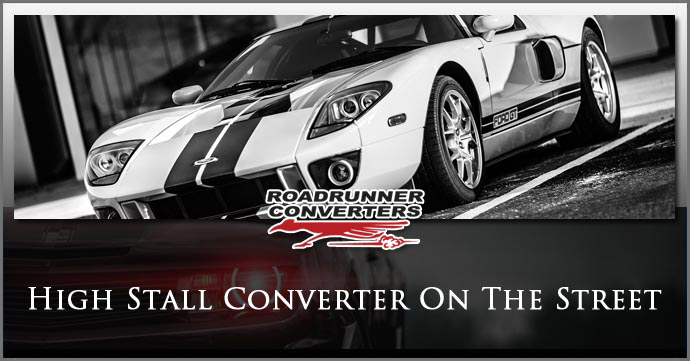If you’re considering using a high stall converter on the street, read this post! When it comes to parts, the stall converter is considered the best bang for your buck. With the majority of street cars that are driven daily we build have stall converters ranging from 2,400 to 3,500, with no problem being street driven. Whereas, we will sometimes use 4,000 RPM stall converters on strip / street cars. The converter used depends on several factors, such as the engine, car itself, plans on being driven, and other variables, like rear-end gearing, weight, and engine torque at certain RPMs.
What do high stall torque converters do?
When it comes to stall converters, there are many opinions volunteered, stating that you will burn the tranny up by using a stall converter on the streets, but larger GM trucks such like UPS, bread trucks, and motor homes have stall converters installed (GM-6, GM-9, etc.) that stall out 2,800 to 3,000 RPM. That’s being installed on heavy duty vehicles getting much more driving compared to a usual daily driver, how many of them have burnt transmission on the side of the road?
Also, another issue to get straight is, just because a 3,000 RPM converter is installed, does not mean the vehicle must rev to 3,000 RPM prior to moving. In the majority of our race cars built, we use 6,000 RPM stall converters and when idling in gear, without using the brake it will begin rolling forward as any other car would with a lower converter. In addition, idling in 1st gear we do about 10mph through the pits with a 6,000 RPM stall converter, how is it the car cannot move until it hits 6,000 RPM? This is just a false concept that never seems to go away.
What Is Stall?
‘Stall’ simply refers to mashing the brake and gas simultaneously, or getting on the trans brake. This enables the engine to rev around the stall RPM of the converter installed prior to breaking tires loose. When sitting at a stop sign, then taking off as you normally would the engine revs up a little higher compared to cars running stock converters. However, it does not rev to the full rated stall RPM prior to moving. In most cases, the car will drive good, until you hit the gas which results in the engine ‘flashing’ to the RPM, similar to putting a clutch in, then revving the engine and dumping it, that is when it all gets loose!
Furthermore, determining which stall converter to install is not exact science. A 3,500 RPM converter can be installed without seeing a 2,500 RPM stall if there is not enough torque provided by the engine. Meanwhile, if you install the 3,500 RPM converter in a vehicle with a big block engine with massive torque, you may get more like 4,000 RPM stall. The amount of raw torque created by the engine will be a big determining factor.
With stall converters, the cool thing they offer is a ‘cush’ for parts such as the gears, U-joints, and axles. Due to the clutch ‘impact’ of manual transmissions, vehicles are hard on these things. However, stall converters are a gentler approach for these parts due to the ‘slip’ it provides.
How High Stall Helps Performance
The stall converter enables a vehicle to use its torque curve for launching off the line stronger and better compared to a vehicle with a lower stall. Let’s explain this a bit better. If you’re engine creates 500-foot lbs of torque at 4,000 RPM and your goal is to launch as hard as possible from the line, you will want to install a 3,800 – 4,000 RPM stall converter. To get a better idea, look at dyno sheets and compare race and performance engines, its easy to tell they build power and torque at a higher RPM, which is why stall converters are critical parts. Therefore, to launch hard form the line as possible, you would not want to install a 3,000 RPM stall converter into a car with peak torque at 5,000 RPM.
If installing a stock 1,100 RPM stall converter in the same race engine, it would fail right away due to the converter getting locked up at a low RPM. This causes the full engine load to stall at 1,100RPM, which the engine would not create the desired power at this RPM. You would find it like attempting to launch off the line in 3rd gear, of course not it would simply stall out and fail without some serious revving and major slipping at the clutch to get going. At 1,100RPM a race or performance engine will create very little power if any, and the majority of these engines idle higher than this. Cars that have lower stalls like this will lag and launch slower than mom’s SUV loaded down with kids.
There is a reason that race and performance cars use higher stall converters and lower gears. Your car can be equipped with the biggest engine available, but with gearing being too tall and a low stall, it will result in your car being a snail off the line. Also, acceleration will be poor. It is common for those who ‘think’ their car is big and bad, have poor times on the track because of gears being too tall, carbs being too large, and low stalls.
Supporting A High Stall Torque Converter
At any time when higher stall converters are installed, you should ensure an external tranny cooler of some type is used. This is due to the massive amounts of heat created when you’re ‘stalling out’ the converter. Hydraulic friction builds heat when launching from the line, and this can cook a tranny without a cooler. After determining when your engine creates good torque, you’re able to use the RPM number for determining the stall converter size that is best used for your car. As you can see, not really rocket science at all.
High Stall Torque Converters
If you’re interested in installing a high stall torque converter for the street in your vehicle; Roadrunner Torque Converters can help! We design and manufacture high performance high stall torque converters for the street and race track. No matter what kind of setup you’ve got our expert staff can help you match your vehicle, engine, curb weight, transmission, and all of the important factors you’d need to consider to choose the right high stall torque converter for your vehicle. For more information about choosing the right torque converter for your rig please call 602-452-0915



